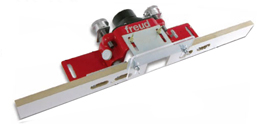
|
ROUTER TABLE FENCESFENCE:The fence is what makes all this work, and work safely. Often you are using a bearing guided bit so technically the fence is kind of redundant, but even in those situation it is beneficial to put the fence in place to protect YOU from the 18,000 rpm lethally rotating cutter, AND house in the shavings for more effective dust collection. So a fence needs to be somewhat flexible in positioning and set up, able to wrap the cutter, and yet still offer good visibility. Independent Adjustment: Fences can be either one solid extrusion along the full length of the table.. like a rip fence on a table saw, or broken in half at the router bit, allowing you to backset the infeed fence for various jointing applications. The latter sounds great but often causes you a lot of pain in trying to align infeed and outfeed fences when more often than not, you need a straight line between the two. Getting them lined up together can be quite challenging so if shopping try putting a straight edge along infeed and outfeed fences and test for parallelism. Adjustment: The most sophisticated fences allow for micro-adjustment on both on the infeed and outfeed portion of the fence, as you see in this picture of the Freud Router Table Fence (most are just manual moving in and out with locking screws from above, threaded into the table top). Micro-adjustment is pretty cool, but expensive and maybe not necessary.. depending on the level of accuracy you are working to.
Router Bit Housing: Some fences have segmented faces where parts of the housing can be set at different in/out distances to wrap around the profile of the cutter. This offers added safety and better dust collection if you can close in the space around the cutter.. At the very least the faces of the fence should be replaceable.. ie. you should be able to unbolt them easily from the main carriage and create new ones as wear makes them more unreliable. Dust pickup: some fences are design with a dust collection shoot. These are great and direct the shavings towards your suction keeping airborne particles to a minimum. Bit Guard: Typically a clear hood that hides the top of the router bits, both for safety as well as better dust collection. Check for good visibility.. often they are a cheap plastic that gets abraded pretty quickly.. but they do keep your fingers away from where the actions happening. Stop: Can have an embedded T-track in the router table fence that is designed to hold either a feathered hold-down or a stop block, both convenient add-ons. Well this brings us to the end of our section on "What makes the Best Router Table". I hope it has helped in your buying or building mindset.
|
|
